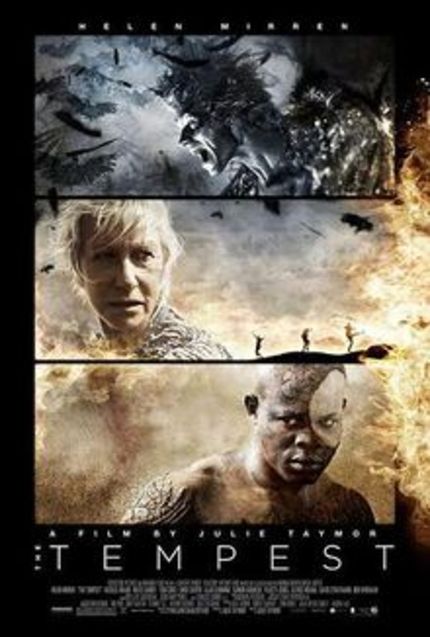NYFF 2010: THE TEMPEST Review

Admittedly, though, Wishaw
is often one of the most watchable things in The Tempest. But
is that necessarily a good thing? Sadly, the film's emphasis on "watchable"
bits is what ultimately helps devolve it from its sublime source material
to mere opportunistic spectacle. Indeed, so intent is she on delivering
highbrow eye-candy, Taymor--whom it's hard to deny is gifted when
it comes to a certain kind of visual expressiveness--ends up using
Shakespeare as a platform for an oddly respectful form of self-indulgence.
Yes, the text here is still, basically, Shakespeare, but that's rather
like saying that Across the Universe is a Beatles movie. In that
earlier film, Taymor drew upon both the movie musical and the music
video to create something that was not quite successful as either, but
kinda worked as a starry-eyed "greatest hits" tribute. That same
feel is present here--the personal immediacy of Shakespeare when it's
done right is missing, and instead we get a careful, occasionally entertaining,
"interpretation" of the text, and that's about it. To be sure,
there are several individual scenes that work, but one never loses sight
of the fact for more than a few minutes that this is a dramatic "production,"
that these are "performances," and that all the special effects
are just that--effects, and often rather disappointing ones at that.
(Wishaw sometimes reminded me of the Marvel character Quicksilver, and
the opening storm-at-sea is an embarrassing mix of obvious CGI and old-fashioned
let's-shake-the-set soundstage work.)
With The Tempest Taymor
finds herself on both familiar and shaky ground. Familiar because she
has brought the play to life on more than one occasion. As a result,
she has a keen sense of its crucial scenes and key moments, and to her
credit she sometimes stands back and lets the impressive cast do its
work and gift us with admirable, if isolated, line readings--but again,
that's the "greatest hits" approach. At the same time Taymor is
on shaky ground because even when her direction is effective it's
effective as stage direction, not film direction. This is particularly
evident in the comedic scenes involving Alfred Molina and a surprisingly
impressive Russell Brand. She places the camera where the high-priced
orchestra seats would be, forgets about embellishing the farcical elements
with post-production showiness, and simply focuses on the action and
dialogue occurring within the shot. Despite enjoying the humor in these
scenes, a colleague of mine found them to be rather stiff, but I'd
contend they only come across as so stagy because the rest of the movie
takes such ridiculous pains to avoid seeming stagy. No, I don't
think I would have liked The Tempest if it had been agonizingly
literal, like Branagh's As You Like It, but I don't think
it would have come to that--Taymor is simply too good as a director
of theater.
The problem is that, despite
some examples to the contrary in Frida, she hasn't achieved
a comparable fluency in film: to her it's a medium that allows for
increased adornment, larger scale, and a higher, more intense level
of detail--all while maintaining greater (i.e., photographic) realism.
In other words, film as a tool for improving on the visual limitations
of the stage. But of course that kind of sensibility is not the same
as, and in fact is not even close to, grasping, let alone mastering,
filmic storytelling itself--the magic that occurs when one is storyboarding
in pre-production, not in meetings with computer animators during post.
Is it possible to wed these two approaches in the same creative artist?
Sure, just take another look at Olivier's Hamlet or, better
still, Orson Welles's Chimes at Midnight, for examples of stage
veterans who knew how to leverage film to underscore Shakespeare's
texts emotionally, not just conceptually. Taymor, in contrast, still
has trouble figuring out the close-up, and seems to disdain the small
things that a camera can do in favor of huge, sweeping gestures. In
one scene involving a trek through a tropical forest, we get a modest
little crane shot, and in its very pedestrian-ness it feels like a breath
of fresh air.
The hollowness of The Tempest's
emotional core, despite some fine work by Helen Mirren in the lead role,
is, strangely, highlighted by Eliot Goldenthal's intriguing score.
A John Zorn-like sonic stew of world-music percussion, big band flourishes,
and whining "downtown" guitars, it's constantly cueing our emotions
on a moment-to-moment basis that recalls live music during a silent
movie. As inventive as it is (I bet it'll sound great on CD or iTunes),
it's also, in the end, rather tiring... which unfortunately holds
true for the entire production. To be clear, the script is solid and
the film is extremely well cast, and these two factors go a long way
toward redeeming its shortcomings. But unfortunately The Tempest
draws upon the strengths of its medium in such a shallow way that the
end result is a decidedly middlebrow entertainment masquerading as an
edgy new "vision." So go ahead and enjoy the performances of Tom
Conti and Chris Cooper and Felicity Jones, and/or several of the others,
but know also that you can safely wait until the film's home video
release to do so.
Sat Oct 2: 7:00pm (Gala
screening/ ATH) Ticket
Info >>
Sat Oct 2: 10:00pm (Festival Screening/ ATH) Ticket Info >>







